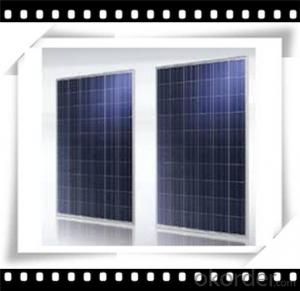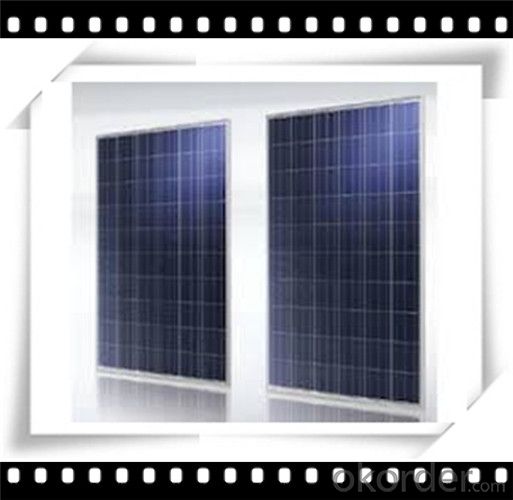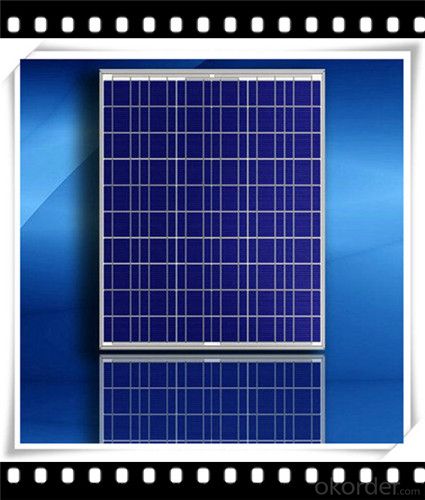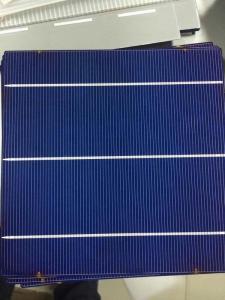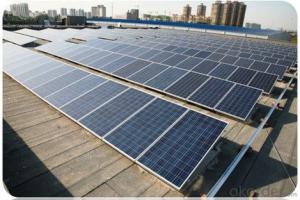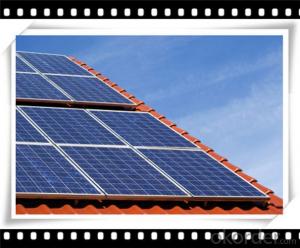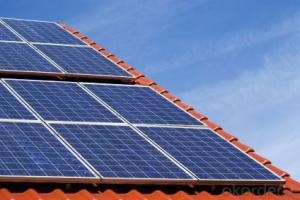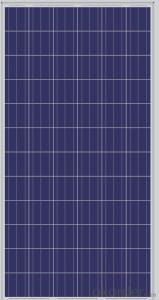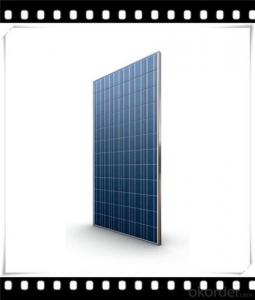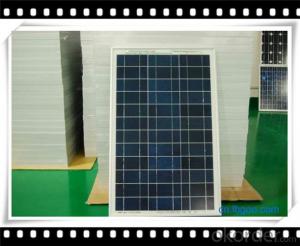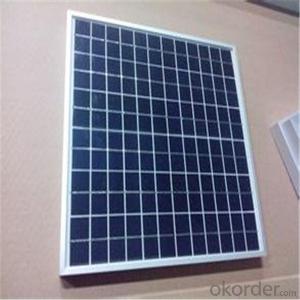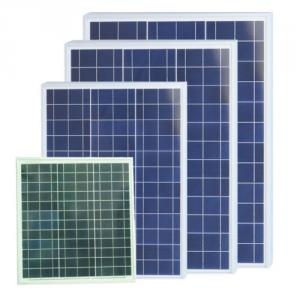280w Poly Solar Panel Medium Solar Panel Newest Solar Panel CNBM - Solar Panels Wholesalers
- Loading Port:
- Qingdao
- Payment Terms:
- TT OR LC
- Min Order Qty:
- 10 set
- Supply Capability:
- 300000 set/month
OKorder Service Pledge
OKorder Financial Service
You Might Also Like
Polycrystalline Solar Modules
CNBM offers a range of small, medium and large polycrystalline solar modules, designed for a range of requirements.
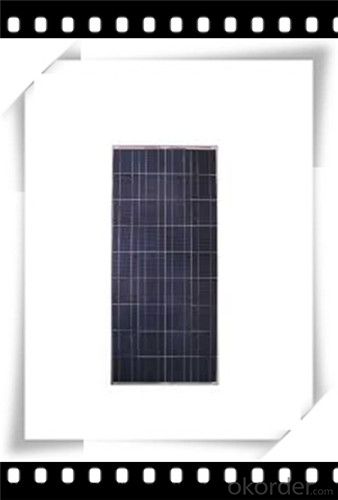
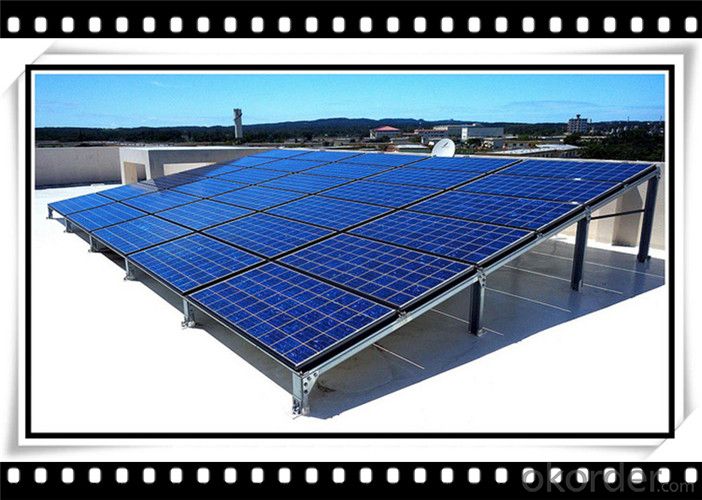
Specifications:
+/-3% |
Polycrystalline silicon solar cells (156 x 156mm) |
60 (10 x 6) |
1650 x 990 x 40 |
25.5 |
Limits:
Operating Temperature | -40~+85? |
Storage Temperature | -40~+85? |
Maximum System Voltage | 1000 VDC max. |
Hail Impact | Diameter of 28mm with impact speed |
Temperature and Coefficients:
NOCT | 48C+/-2? |
Voltage temperature coefficient (%/K) | -0.35 |
Current temperature coefficient (%/K) | 0.05 |
Power temperature coefficient (%/K) | -0.45 |
Characteristics:
Model: | SGM-200P | SGM-210P | SGM-220P |
Max-power voltage Vmp (V) | 29.2 | 29.4 | 29.41 |
Max-power current Imp (A) | 6.85 | 7.14 | 7.48 |
Open-circuit voltage Voc (V) | 36.5 | 36.69 | 36.9 |
Short-Circuit Current Isc (A) | 7.28 | 7.6 | 7.93 |
Max-power Pm(W) | 200 | 210 | 220 |
Model: | SGM-230P |
Max-power voltage Vmp (V) | 29.8 |
Max-power current Imp (A) | 7.72 |
Open-circuit voltage Voc (V) | 37.31 |
Short-Circuit Current Isc (A) | 8.19 |
Max-power Pm(W) | 230 |
STC: Irradiance 1000W/m2, module temperature 25?, AM-=1.5
Poly Crystalline Solar Panels Specifications Range
Maximum Power (Pm) | Dimension | Weight | Operating Voltage (Vmp) | Operating Current (Imp) | Open Circuit Voltage (Voc) | Short Circuit Current (Isc) |
0.45W | 140x80x10mm | 0.08kg | 3.3V | 150mA | 4.6V | 160mA |
1.0W | 162x140x10mm | 0.16kg | 7.5V | 150mA | 10.3V | 160mA |
4.5W | 269x251x23mm | 0.8kg | 16.5V | 0.27A | 20.5V | 0.3A |
10W | 420.1×268.9×22.6mm | 1.92kg | 17.5V | 0.58A | 20.5V | 0.6A |
20W | 425x502x50mm | 3.0kg | 16.8V | 1.19A | 21.0V | 1.29A |
30W | 593x502x22.6mm | 3.9kg | 16.8V | 1.78A | 21.0V | 1.94A |
40W | 655x537x50mm | 5.75kg | 17.3V | 2.31A | 22.1V | 2.54A |
50W | 839x537x50mm | 6.0kg | 17.5V | 2.9A | 21.8V | 3.17A |
65W | 1111x502x50mm | 7.2kg | 17.6V | 3.69A | 22.1V | 3.99A |
80W | 1204x537x50mm | 7.7kg | 17.6V | 4.55A | 22.1V | 4.8A |
- Q: I am curious about how much of the energy that a solar panel of a given size and capacity will produce in it's lifetime, and what fraction of that energy was required to produce it in the first place?
- At present the technology to create silicon solar cells is incredibly energy intensive. It is not logical to compare the cost of oil to the cost of a solar cell because they are not priced according to energy input. Oil has a strong advantage in that it is concentrated solar and geothermal chemical energy that has accumulated over millions of years. The price of oil does not reflect its energy content, but the cost to retreive it. Electrical energy used to produce a Photovoltaic cell is not priced in any proportion to oil. By some calculations it will take about 50,000 KWh of energy produced by the PV cell before it can recover the energy used to manufacture it.
- Q: this solar panel i saw was for 500 dollars(i get a 25% discount)and i was curious will they produce electricity? or just heat?what do they do?is it a good investment?here is a link to the one i would like, no reviews but it looks new to the site.
- This is a photovoltaic panel...it produces electricity from incident solar radiation. Solar thermal panels produce heat, and they are usually assists for hot water heating systems. Solar thermal panels have piping in them instead of semiconductor cells like photovoltaics do.
- Q: I am doing a report about solar power and I need to know what determines the amount of electricity produced?example: exposure to sun, angle of panel, qualityplease tell me as much as you canmuch appreciated
- irradiance in watts/meter^2 (000-800w/m^2 depending on air quality) COS of angle to the suns rays efficiency of the panels (usually about 5%) age of the panels(one dead cell can drop an entire panel from the array) how dirty are the panels (dust, bird poop, leaves, shading) efficiency of the inverter (usually about 90%) All of these factors affect the amount of electricity produced. One other consideration is that in areas of extreme hot and cold the band gap of the silicon is changed.
- Q: Can solar panels be used for powering a research facility or laboratory?
- Yes, solar panels can be used to power a research facility or laboratory. Solar panels convert sunlight into electricity, providing a sustainable and renewable source of power. By harnessing solar energy, research facilities and laboratories can reduce their reliance on traditional energy sources and contribute to a greener and more environmentally friendly operation. Additionally, solar panels can be integrated into the existing infrastructure of the facility, making them a viable option for powering various scientific equipment and systems.
- Q: my dad met a guy representive for a solar panel company at a swapmeet Scam?
- Hard to say. Solar panels are becoming more common these days. May want to ask if the vendor is licensed and bonded contractor (if he's doing installation as well as panel sales). Find out the name of the equipment that this guy is selling (panels and other hardware) and do a search. For that matter, get the guys name and do a search on it to see he pops up elsewhere.
- Q: i would like to hook up a power outlet to a solar panelmy light system is 500watts will run for 8 hours/day between noon to 8PM.So what is the most effective system do I need?
- Most efficient manner would probably be to use solatubes, or sun tunnels during lighting hours, then replace the 500 watt lighting system (assuming it's incandescent) with LED's, that should give you about the same light output for around 00 watts or a little less even. Then you need a solar panel that can produce 00 watts for as long as you want (at a 00 watt lighting system) or 200 watts for /2 the time you want, etc, etc. Allow a good 0% or so for inverter inefficiencies, and 0% or so for reserve, so 20 watt's per 00 watts. After you have this, you will want a charging controller, a battery, or battery bank (These should at very least be deep-cycle, or better yet golf-cart batteries with series between 2, and parallel between banks of 2 for the 2-volt portion of the system), with enough amp-hours to support your system, plus a good 0% or so reserve, plus another 0% or so for inverter inefficiencies (remember the over sized solar panel above, this is why), than of course you also need a 2-volt DC to 20-volt AC, 60 Hz system (or 240 volt AC 50 Hz system, depending on your AC system) inverter.
- Q: Can solar panels be used in areas with high wind speeds?
- Yes, solar panels can be used in areas with high wind speeds. However, it is important to consider the structural integrity of the mounting system to ensure that the panels can withstand strong winds. Additionally, proper installation and maintenance are crucial to ensure the longevity and efficiency of the solar panels in such conditions.
- Q: Can solar panels be damaged by hail or extreme weather?
- Yes, solar panels can be damaged by hail or extreme weather. While solar panels are designed to withstand various weather conditions, including hail, severe storms with large hailstones or intense winds can potentially cause damage to the panels. However, most solar panels undergo rigorous testing to ensure they can withstand such conditions, and many manufacturers offer warranties to cover any damage caused by hail or extreme weather.
- Q: Can solar panels be installed on historical buildings?
- Yes, solar panels can be installed on historical buildings. However, it requires careful planning and consideration to ensure that the installation does not compromise the building's historical integrity. Various techniques can be employed, such as integrating solar panels into existing structures, using non-penetrating mounting systems, or placing panels in less visible areas. Preservation guidelines and local regulations should be followed to maintain the historical significance while promoting sustainable energy.
- Q: What is the average size of a solar panel?
- The average size of a solar panel is typically around 65 inches by 39 inches, or approximately 5.4 feet by 3.25 feet. However, the actual size can vary depending on the manufacturer and the specific model of the solar panel.
Send your message to us
280w Poly Solar Panel Medium Solar Panel Newest Solar Panel CNBM - Solar Panels Wholesalers
- Loading Port:
- Qingdao
- Payment Terms:
- TT OR LC
- Min Order Qty:
- 10 set
- Supply Capability:
- 300000 set/month
OKorder Service Pledge
OKorder Financial Service
Similar products
Hot products
Hot Searches
Related keywords
